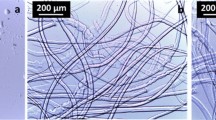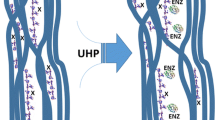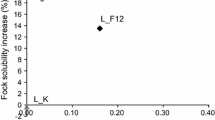Abstract
This work describes the comprehensive characterization of the degradation products obtained after the alkaline steeping of dissolving pulp. Total chlorine free bleached beech sulfite pulp was treated with 18 % sodium hydroxide at different temperatures (40, 50 and 60 °C) for time periods of up to 80 h. After the removal of the insoluble cellulose, the remaining alkali solution was treated with sulfuric acid to precipitate the β-fraction. With extended treatment times and temperatures, the proportion of xylan in the β-fraction is increased. However, the molar mass distribution and the amount of 4-O-methylglucuronic acid in the β-fraction revealed no clear trend as a function of the treatment conditions. In total 13 hydroxy acids were identified in the acid soluble γ-fraction, of which glucoisosaccharinic, glycolic, lactic and xyloisosaccharininc acids were among the most abundant hydroxy acids representing the degradation products from C6- and C5-sugars.






Similar content being viewed by others

Abbreviations
- AEC:
-
Anion exchange chromatogrphy
- Ara:
-
Arabinose
- BAR:
-
Benzilic acid rearrangement
- COD:
-
Chemical oxygen demand
- DOC:
-
Dissolved organic carbon
- DP:
-
Degree of polymerization
- FID:
-
Flame ionization detector
- Gal:
-
Galactose
- GC–MS:
-
Gas chromatography with mass spectroscopy detector
- GISA:
-
Glucoisosaccharinic acid
- Glc:
-
Glucose
- GlcA:
-
Glucuronic acid
- HPLC:
-
High performance liquid chromatography
- Man:
-
Mannose
- Me:
-
Methyl
- MMD:
-
Molar mass distribution
- Mn:
-
Number-average molar mass
- Mw:
-
Weight-average molar mass
- Mz:
-
Z-average molar mass
- odp:
-
Oven dried pulp
- PAD:
-
Pulse amperometric detection
- Rha:
-
Rhamnose
- SEC:
-
Size exclusion chromatography
- TCF:
-
Total chlorine free
- TOC:
-
Total organic carbon
- Xyl:
-
Xylose
References
Alén R, Niemelä K, Sjöström E (1984) Gas-liquid chromatographic separation of hydroxy monocarboxylic acids and dicyrboxylic acids on a fused-silica capillary comlumn. J Chromatogr 301:273–276
Aspinall GO, Greenwood CT, Sturgeon RJ (1961) The degradation of xylans by alkali. J Chem Soc 3667–3674
Bertaud F, Sundberg A, Holmbom B (2002) Evaluation of acid methanolysis for analysis of wood hemicelluloses and Pectins Carbohyd Polym 48:319–324
Glaus MA, Van Loon LR (2008) Degradation of cellulose under alkaline conditions: new insights from a 12 years degradation study. Environ Sci Technol 42:2906–2911
Glaus MA, Van Loon LR, Achatz S, Chodura A, Fischer K (1999) Degradation of cellulosic materials under the alkaline conditions of a cementitious repository for low and intermediate level radioactive waste Part I: identification of degradation products. Anal Chimica Acta 398:111–122
Götze K (1967) Chemiefasern nach dem Viskoseverfahren. Springer, New York
Haas DW, Hrutfiord BF, Sarkanen KV (1967) Kinetic study on the alkaline degradation of cotton hydrocellulose. J Appl Polym Sci 11:587–600
Hansson J-A, Hartler N (1970) Alkaline degradation of pine glucomannan. Holzforschung 24:54–59
Johansson M, Samuelson O (1974) The formation of end groups in cellulose during alkali cooking. Carbohyd Res 34:33–43
Johansson MH, Samuelson O (1977) Alkaline destruction of birch xylan in the light of recent invwstigations of its structure. Sven Papperstidn 16:519–524
Knill CJ, Kennedy JF (2003) Degradation of cellulose under alkaline conditions. Carbohyd Polym 51:281–300
Kolpak FJ, Weih M, Blackwell J (1978) Mercerization of cellulose: 1. Determination of the structure of Mercerized cotton. Polymer 19:123–131
Krässig HA (1993) Cellulose: structure, accessibility and reactivity; methods of activation vol 11. Gordon and Breach Science Publishers, New York
Kürschner K, Karácsonyi S (1961) Zur Isolierung von Hemicellulosen aus Buchenholz (Fagus silvatica L.) und aus Buchenholz-Holocellulose. Holzforschung 15:107–114
Machell G, Richards GN (1957) The alkaline degradation of polysaccharides. Part II. The alkali-stable residue from the action of sodium hydroxide on cellulose. J Chem Soc 4500–4506
Mais U, Sixta H (2004) Characterization of alkali-soluble hemicelluloses of hardwood dissolving pulps. In: ACS symposium series, vol 864 (Hemicelluloses), pp 94–107
Mozdyniewicz DJ, Nieminen K, Sixta H (2013) Alkaline steeping of dissolving pulp. Part I: cellulose degradation kinetics. Cellulose 20:1437–1451
Niemelä K (1987) Identification of novel cellulose degradation products. Acta Chem Scand B 41:257–260
Niemelä K (1990a) Conversion of xylan, starch, and chitin into carboxylic acids by treatment with alkali. Carbohyd Res 204:37–49
Niemelä K (1990b) The formation of hydroxy monocarboxylic acids and dicarboxylic acids by alkline thermochemical degradation of cellulose. J Chem Tech Biotechnol 48:17–28
Niemelä K, Sjöström E (1986a) Alkaline degradation of mannan. Holzforschung 40:9–14
Niemelä K, Sjöström E (1986b) The conversion of cellulose into carboxylic acids by a drastic alkali treatment. Biomass 11:215–221
Pavasars I, Hagberg J, Borén H, Allard B (2003) Alkaline degradation of cellulose: mechanisms and kinetics. J Polym Environ 11:1015–2636
Richards GN, Sephton HH (1957) The alkaline degradation of polysaccharides. Part I. Soluble products of the action of sodium hydroxide on cellulose. J Chem Soc 4492–4499
Richtzenhain H, Lindgren BO, Abrahamsson B, Holmberg K (1954) Über den alkalischen Abbau von Polysacchariden. I. Mitteil.: Abbau von Baumwollhydrocellulose. Sven Papperstidn 57:363–366
Röder T, Moosbauer J, Kraft G, Woess K, Schlader S (2013) Man-made cellulose fibers: a comparison. In: 245th ACS national meeting and exposition, New Orleans, LA, United States, 7–11. April 2013. American Chemical Society, Washington, DC, pp CELL-131
Sartori J, Potthast A, Rosenau T, Hofinger A, Sixta H, Kosma P (2004) Alkaline degradation of model compounds related to beech xylan. Holzforschung 58:588–596
Sixta H, Schelosky N, Milacher W, Baldinger T, Röder T (2001) Characterization of alkali-soluble pulp fractions by chromatography, vol 3. Nice, France
Speck JC (1958) The Lobry De Bruyn-Alberda Van Ekenstein transformation. Adv Carbohyd Chem 13:63
Sundberg A, Sundberg K, Lillandr C, Holmbom B (1996) Determination of hemicelluloses and pectins in wood and pulp fibres by acid methanolysis and gas chromatography. Nordic Pulp Pap Res J 11:216–219
Vähä-Nissi M, Ropponen J, Niemelä K, Mehtiö T, Hytönen E, Harlin A (2013) Polymers from Kraft pulping spent liquor. In: COST FP1003, Bratislava
Van Loon LR, Glaus MA (1997) Review of the kinetics of alkaline degradation of cellulose in view of its relevance for safety assessment of radioactive waste repositories. J Environ Polym Degrad 5:97–109
Van Loon LR, Glaus MA (1998) Technical report 97-04: experimental and theoretical studies on alkaline degradation of cellulose and its impact on the sorption of radionuclides. Hannover
Van Loon LR, Glaus MA, Laube A, Stallone S (1999) Degradation of cellulosic materials under the alkaline conditions of a cementitious repository for low- and intermediate-level radioactive waste. II. Degradation kinetics. J Environ Polym Degrad 7:41–51
Vuorinen T, Alén R (1999) Carbohydrates. In: Sjöström E, Alén R (eds) Analytical methods in wood chemistry, pulping and papermaking. Springer, Berlin, pp 37–67
Wang S-H, McCarthy JL, Ferguson JF (1993) Utilization of glucoisosaccharinic acid and components of Kraft black liquor as energy sources for growth of anaerobic bacteria. Holzforschung 47:141–148
Xu C, Pranovich A, Vähäsalo L, Hemming J, Holmbom B (2008) Kinetics of acid hydrolysis of water-soluble spruce O-acetyl galactoglucomannans. J Agric Food Chem 56:2429–2435
Young RA, Liss L (1978) A kinetic study of the alkaline endwise degradation of gluco- and galactomannans. Cellulose Chem Technol 12:399–411
Acknowledgments
Financial support was provided by the Austrian government, the provinces of lower Austria, upper Austria, and Carinthia as well as by Lenzing AG. We also express our gratitude to the Johannes Kepler University, Linz, the University of Natural Resources and Applied Life Sciences, Vienna, and Lenzing AG for their in-kind contributions. The authors gratefully thank Dr. Hannu Pakkanen and Mrs. Marja Salo from Laboratory of Applied Chemistry, Department of Chemistry, at the University of Jyväskylä for their analyses of the hydroxy acids.
Author information
Authors and Affiliations
Corresponding author
Rights and permissions
About this article
Cite this article
Mozdyniewicz, D.J., Schild, G. & Sixta, H. Alkaline steeping of dissolving pulp. Part II: Soluble compounds in the press lye. Cellulose 21, 2889–2900 (2014). https://doi.org/10.1007/s10570-014-0291-6
Received:
Accepted:
Published:
Issue Date:
DOI: https://doi.org/10.1007/s10570-014-0291-6



